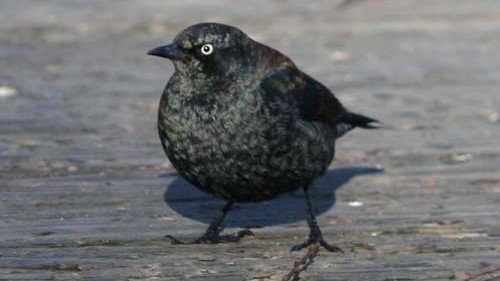How many of us are really aware of the plight of the Rusty Blackbird? Sure, it’s not flashy, it’s rarely a target species for many as it’s buried there in the back of the field guide, and often can be difficult to tell from other blackbirds especially given the Icterid propensity to hang out together during the cold months. But of all the species that have suffered declines in North America (and sadly, it’s many), the Rusty has quietly suffered one of the most severe. According to Breeding Bird Survey and Christmas Bird Count statistics, the Rusty Blackbird population has collapsed, down a staggering 80-90% since the 1960s. The bird is in serious trouble.
The species’ decline is poorly understood and, as with most threatened birds, likely includes the usual suspects like habitat degradation, but there are other possibilities too. In many states blackbirds, characterized as not only the ever present grackles, starling and red-wings but also the Rusty are listed as nuisance birds. Therefore, one is allowed to take as many as one wants if the birds are, and this is directly from Federal law (emphasis mine), “committing or about to commit depredations on ornamental or shade trees, agricultural crops, livestock, or wildlife, or when concentrated in numbers and in a manner that constitutes a health hazard or other nuisance“. There is a lot of gray area there. In short, you can shoot Rusty Blackbirds practically whenever you want. Worse, the USDA and the state of North Dakota, concerned about the effect of mixed flocks of blackbirds on sunflower crops, is currently testing a plan to bait the birds with poison-laced brown rice on their spring migration. Migratory Bird Act need not apply apparently.
The problem, of course, is that there are no provisions differentiating starlings and grackles, which certainly can be agricultural nuisances in large numbers, from our Rusty Blackbird, it of the dramatically nose-diving population. The blackbird cull is completely indiscriminate. Rusties do, in fact, pass through North Dakota on their way to nesting grounds in Canada, and it’s not beyond to the realm of possibility that a significant chunk of the breeding population is poisoned before they even get to their destination. And if no qualifications are made – or even possible – the Rusty Blackbird’s unfortunate resemblance to more problematic species may write its ticket right into extinction.
So we’re well aware of the bad hand the Rusty Blackbird has drawn. And it can be overwhelming to sit there as a birder and feel completely helpless as these forces largely out of our control conspire to take one of North America’s unique bird species away from us right before our eyes. But in this case there is something you can, in fact, do to help. In heart of darkest cynicism shines a glimmer of hope.
While the still vast boreal bogs across Canada make up their breeding range, Rusty Blackbirds spend the rest of the year, up to 8 months, the across a swath of the generally southern United States, from New Jersey all the way across the coastal plain to eastern Texas. The core of that range, however, is still the southeastern United States, and the the largest concentrations of Rusty Blackbirds can be found in swampy lowlands in South Carolina, Georgia and Louisiana. Fortunately, the birders in those areas can help
The Smithsonian Institution, with help from Cornell Lab of Ornithology is launching their third and final Rusty Blackbird Blitz, encouraging birders from several states in the southeast and lower midwest to go out over a three week period, from January 29 to February 13, with Rusty Blackbirds specifically in mind. Your bird lists, either with or without Rusties (negative data is still data!), should be submitted to Cornell via eBird. More specific details are available here.
You should do this for several reasons.
First; Rusty Blackbirds are in big trouble and we need to know where they are when they are so that appropriate habitat can be preserved.
Second; data collection via eBird will introduce you to what is a phenomenal tool for your personal birding records as well as a way for scientists to compile data on bird populations and movements. In many ways conventional “citizen science” rarely provides useful data sets, but eBird is that rare project that is actually enormously useful for scientists and birders, and when more people use it, its usefulness grows exponentially.
Third; you’re already going to be birding then anyway, right? Might as well look for Rusties!
I hope the case is easily made. The bottom line is that Rusty Blackbirds need your help and that you have the opportunity to offer it. So get out there and look for Blackbirds, folks!














And the man in the back said “Everyone attack!” and it turned into a Blackbird Blitz.
The birder in the corner said “Boy I’m gonna warn you, it’ll turn into a Blackbird Blitz.”
Thanks for the info, Nate. Sobering. I haven’t contributed to eBird in a very long time, but I will for these blackbirds if I can pick them out of the crowd.